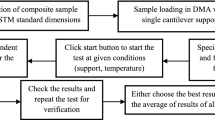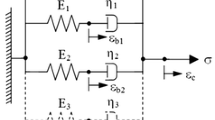Abstract
The material damping of rotors causes instability by introducing tangential force to whirl orbit. Literature shows that the improvement of stability range is achieved using fibre-reinforced composites or layered rotors which are light yet strong and exhibit better damping properties. In this study, a multi-layered viscoelastic propeller shaft mounted on three journal bearings is considered. Higher order finite-element model is developed after utilizing operator-based constitutive relationship, which includes various asymmetries from several sources like gyroscopic effect, internal damping, and journal bearing support. A large number of states of the higher order model, as well as the presence of asymmetry, make the system complicated for post-processing. Modified system equivalent reduction expansion process (SEREP) is applied for model reduction that uses both right and left eigenvectors of the original propeller-shaft system. Different numerical results are compared to test the effectiveness of reduced model. Though SEREP is found in the literature, its application over most realistic and higher order asymmetric system is completely new.









Similar content being viewed by others

References
Bland DR (1960) The theory of linear viscoelasticity. Pergamon Press, Oxford
Zorzi ES, Nelson HD (1977) Finite element simulation of rotor—bearing systems with internal damping. J Eng Power Trans ASME 99:71–76. https://doi.org/10.1115/1.3446254
Guran A, Rimrott FPJ, Janabi-Sharifi F (1991) On the stability of a spinning viscoelastic column. J Struct Mech 19(4):437–455. https://doi.org/10.1080/08905459108905151
Dutt JK, Roy H (2011) Viscoelastic modelling of rotor-shaft systems using an operator-based approach. J Mech Sci Inst Mech Eng Part C 225(1):73–87. https://doi.org/10.1243/09544062JMES2064
Jivkov VS, Zahariev EV (2014) Stability and nonstationary vibrations of rotor in elastoviscous field. Mech Based Des Struct Mach 42(1):35–55. https://doi.org/10.1080/15397734.2013.814545
Montagnier O, Hochard C (2014) Dynamics of a supercritical composite shaft mounted on viscoelastic supports. J Sound Vib 333:470–484. https://doi.org/10.1016/j.jsv.2013.09.021
Roy H, Dutt JK (2016) Dynamics of polymer and polymer composite rotors—an operator based finite element approach. Appl Math Model 40:1754–1768. https://doi.org/10.1016/j.apm.2015.08.021
Roy H, Chandraker S, Dutt JK, Roy T (2016) Dynamics of multilayer, multidisc viscoelastic rotor—an operator based higher order classical model. J Sound Vib 369:87–108. https://doi.org/10.1016/j.jsv.2015.12.047
Roy H, Chandraker S (2017) Dynamic study of viscoelastic rotor: modal analysis of higher order model considering various asymmetries. Mech Mach Theory 109:65–77. https://doi.org/10.1016/j.mechmachtheory.2016.11.003
Guyan RJ (1965) Reduction of stiffness and mass matrices. Am Inst Aeronaut Astronaut 3(2):380–380. https://doi.org/10.2514/3.2874
O'Callahan JC (1989) A procedure for an improved reduced system (IRS) model. In: Proceedings of the seventh international modal analysis conference, Las Vegas, pp 17–21
Gordis JH (1992) An analysis of the improved reduced system (IRS) model reduction procedure. In: 10th international modal analysis conference, San Diego, vol 1(A94-12476 02-39), pp 471–479
Friswell MI, Garvey SD, Penny JET (1998) The convergence of the iterated IRS methods. J Sound Vib 211(1):123–132. https://doi.org/10.1006/jsvi.1997.1368
Chandraker S, Roy H (2014) A balanced IIRS model for investigating the dynamics of damped rotor bearing system. In: Proceedings of the ASME gas turbine India conference V001T06A014. https://doi.org/10.1115/GTINDIA2014-8279
Chandraker S, Roy H (2016) Dynamic study of viscoelastic rotor: reduction of higher order model using different techniques. Aerosp Sci Technol 58:306–317. https://doi.org/10.1016/j.ast.2016.08.006
O'Callahan JC, Avitable P, Riemer R (1989) System equivalent reduction expansion process (SEREP). In: Proceedings of the seventh international modal analysis conference. Las Vegas, pp 29–37
Friswell MI, Inman DJ (1999) Reduced-order models of structures with viscoelastic components. Am Inst Aeronaut Astronaut 37(10):1325–1328. https://doi.org/10.2514/2.603
Friswell MI, Penny JET (1998) Garvey SD (2001) Model reduction for structures with damping and gyroscopic effects. Proc Int Semin Modal Anal KU Leuven 3:1151–1158
Das A, Dutt JK (2008) Reduced model of a rotor shaft system using modified SEREP. Mech Res Commun 35:398–407. https://doi.org/10.1016/j.mechrescom.2008.04.004
Zhang Z, Zhang Z, Huang X, Hua H (2014) Stability and transient dynamics of a propeller-shaft system as induced by nonlinear friction acting on bearing-shaft contact interface. J Sound Vib 333(12):2608–2630. https://doi.org/10.1016/j.jsv.2014.01.026
Meirovitch L (1975) Elements of vibration analysis. McGraw-Hill Science, Engineering & Mathematics, New York
Author information
Authors and Affiliations
Corresponding author
Additional information
Publisher’s Note
Springer Nature remains neutral with regard to jurisdictional claims in published maps and institutional affiliations.
Rights and permissions
About this article
Cite this article
Ganguly, K., Roy, H. SEREP-based reduced model of higher order viscoelastic propeller shaft considering various asymmetries. Engineering with Computers 37, 3237–3249 (2021). https://doi.org/10.1007/s00366-020-00978-0
Received:
Accepted:
Published:
Issue Date:
DOI: https://doi.org/10.1007/s00366-020-00978-0



